
Material Formats
We process a variety of film formats here at ScanDigital. To better identify what format you have, please review the image examples and detailed descriptions below. Given our extended list of film types, our service can likely handle your entire photography archive. Each type of film format requires a different process that our professional technicians are qualified to handle. We also have the top of the line equipment, including several varieties of a photo slide scanner to process most all formats. If you are still unsure about your film format type, our customer service team is always happy to help.
Film And Negative Formats
 35mm Negatives (also referred to as 35mm, 135 or Standard Format)
35mm Negatives (also referred to as 35mm, 135 or Standard Format)
35mm is the most popular film format for photography. Each individual frame is 24mm x 36mm (tall x wide) with a 2 mm gap between each frame. The film is perforated at the top and bottom with the frame number printed on the top and/or the bottom of the frame. Each frame has 8 perforations on both the top and bottom. Often 35mm film comes in tight single spooled metal cassettes.
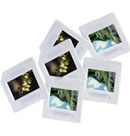 35mm Slides
35mm Slides
35mm Slides are individual 35mm Negatives housed in a 2"x 2" mount. The mounts are usually made of plastic or dense cardboard. The size of the frame that displays is usually 23mm x 34mm (tall x wide) depending on the manufacturer.
 110 Negatives: (also referred to as Instamatic)
110 Negatives: (also referred to as Instamatic)
110 film was created for Kodak Instamatic cameras in 1972. Each individual frame is 13mm x 17mm (tall x wide) and contains one registration hole or perforation.
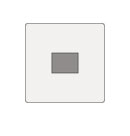 110 Slides
110 Slides
110 Slides are individual 110 Negatives housed in a 2"x 2" mount. The mounts are usually made of plastic or dense cardboard. The size of the frame that displays is usually 12mm x 16mm (tall x wide).
 APS Negatives (also referred to as Advantix)
APS Negatives (also referred to as Advantix)
APS stands for Advanced Photo System and was developed by Kodak in 1996 to give photographers the option to shoot in three photo sizes. Below are the definitions for the three photo size options.
| H = "High Definition" | C = "Classic" | P = "Panoramic" |
| Film Size: 30.2mm x 16.7mm | Film Size: 25.1mm x 16.7mm | Film Size: 30.2mm x 9.5mm |
| Print Size: 4"x7" | Print Size: 4"x6" | Print Size: 4"x12" |
APS Negatives come in a long plastic cassettes. Numbered symbols (called 'visual indicators') on the cartridge end indicate the status:
Full circle: Unexposed
Half circle: Partly exposed
Cross sign: Fully exposed but not processed
Square: Processed
*Important Note: Please only send processed APS cassettes where the square is selected. See images below.
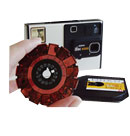 Disc Film
Disc Film
Disc film is in the form of a flat disc, and is fully housed within a plastic cartridge. Each disc holds 15 exposures, where the disc is rotated 24° between every image. Those fifteen 11mm x 8mm images are arranged around the outside of the disc. This type of film was developed by Kodak in 1982 but was discontinued in 1998.
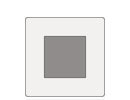 126 Instamatic (also referred to as Instamatic)
126 Instamatic (also referred to as Instamatic)
126 is the number given to a cartridge-based film format. It was introduced by Kodak in 1963, and is associated mainly with low-end point-and-shoot cameras, particularly Kodak's own Instamatic series of cameras. Although 126 were once very popular, as of 2006 it is no longer manufactured. The frame size is 28mm x 28mm and has only one perforation at the bottom.
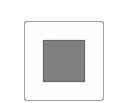 126 Slides
126 Slides
126 Slides are individual 126 Negatives housed in a 2"x 2" mount. The mounts are usually made of plastic or dense cardboard. The size of the frame that displays is about 26.5mm x 26.5mm (tall x wide).
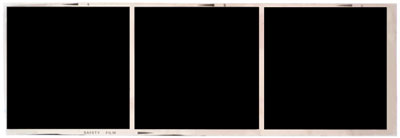 120 Medium Format
120 Medium Format
The most common medium format film is 6cm x 6cm with a frame size of 56mm x 56mm. The number of the frame is usually printed on the top or bottom of the frame. Medium format is often used by professional photographers because it offers higher image resolution than traditional 35mm (135) film. Other medium format sizes included 6cm x 4.5cm, 6cm x 7cm, 6cm x 8cm and 6cm x 9cm.
 Large Negatives
Large Negatives
Large Negatives refer to negatives with dimensions larger than 120 film (2.25" x 2.25") up to 4" by 5" dimensions. In general, because of the size of the negatives, a lower resolution scan is sufficient. We scan large formatted negatives at 1000DPI or 2000DPI.
 Large Transparencies
Large Transparencies
Large Transparencies are thin sheets of transparent flexible material, typically cellulose acetate, onto which figures can be printed or drawn. These are then placed on an overhead projector for display to an audience. Large transparencies are typically the approximate size of a legal sheet of paper 8 ½" x11", however they can range in various sizes.
Subscribe
Get specials and discounts delivered to your inbox!
Questions?
Local: 1.317.863.3986
Business Hours (Eastern):
Monday - Friday: 9 AM - 6 PM
Saturday: 10AM - 4PM
Sunday: Closed
Your memories are safe
 Through our integration with UPS and our world class EssentialTracker system for
internal tracking, your order is carefully monitored from door to door
Through our integration with UPS and our world class EssentialTracker system for
internal tracking, your order is carefully monitored from door to door
We scan by hand
 To ensure the highest quality and to protect every image, we will never use an auto-feeder to process your materials.
To ensure the highest quality and to protect every image, we will never use an auto-feeder to process your materials.
Testimonials
"First I want to thank you for the opportunity. I was very pleased with what I received from your company. I sent out many negatives. Thanking you in advance."
- Jill MO December 2010 -
Ideas Center
 Preserve your favorite vacation memories. You will love reliving your travel adventures on DVD!
Preserve your favorite vacation memories. You will love reliving your travel adventures on DVD!
As mentioned in











